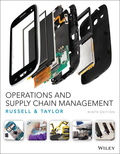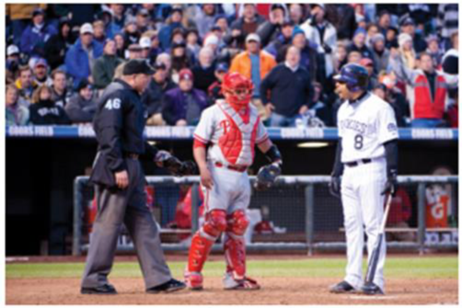
Concept explainers
It used to be that major league baseball (MLB) umpires were scheduled on an Excel spreadsheet. The task took several weeks and had to be revised often. Now they use a scheduling system developed by researchers at the University of Miami, Carnegie Mellon, and Michigan State University. A variant of the classic Traveling Salesman problem, umpires, as shown in the photo, are assigned to crews that must visit all ballparks at least once during the year. Of course, there are many more constraints.

Perspectives/Jeff Smith/Shutterstock
MLB teams play 2430 games in a two- to four-game series during a six-month season. Each game requires a crew of four umpires. There are currently 70 umpires on MLB staff, and 22 AAA umpires who may be called up as needed to fill in for games. A typical umpire will handle 142 games a year. Unlike football referees, umpires are full-time employees of MLB. Umpires are normally assigned to crews, but the content of these crews can change during the year. Constraints to umpire crew scheduling include mandated vacations, overexposure to individual teams, prohibition to refereeing at home, and minimizing coast-to-coast travel. Examples of MLB rules used to enforce these constraints are:
- Crews should travel to all 30 ballparks at least once during a season.
- Crews should not umpire the same team’s series of games more than once every 18 days.
- Crews must not travel from the West Coast to the East Coast without an intermediate day off.
- Crews must not umpire consecutive series more than 1700 miles apart without an intermediate day off.
- Crews must not travel more than 300 miles preceding a series whose first game is a day game.
- Crews should not work more than 21 days without a day off.
- Crews should see each team at home and on the road at least once.
- Crews should have balanced schedules (i.e., travel approximately the same number of miles, umpire the same number of games, and have the same number of days off).
Real-life scheduling problems, like umpire scheduling, can be quite complex. The general solution approach is similar to the assignment method of linear programming described in this chapter. There is an objective function of minimizing distance traveled subject to a number of constraints, as listed earlier. The variables are (0,1) meaning an umpire is either assigned to a game slot (i.e., 1), or not (i.e., 0), and the game slots are numerous (2430 × 4 = 9720). While this can be solved as an integer linear programming (LP) problem, the length of time to do so and the inability to relax constraints make it difficult to find a feasible solution.
Academics use heuristics, or rules of thumb, to solve these types of problems. Heuristics do not necessarily satisfy all constraints and do not guarantee an optimal solution, but they can give satisficing or “good enough” solutions. The heuristics are evaluated against performance metrics, previous solutions, and “optimal” solutions (from mathematical programming such as LP). The heuristics are usually improved on with use until users accept them. Many are then coded into software and sold as scheduling systems for particular applications.
Approximate the number of possible solutions for this problem. With computer systems able to process huge amounts of data quickly, would it be possible to enumerate all possible schedules and choose the best? Investigate.
Want to see the full answer?
Check out a sample textbook solution
Chapter 17 Solutions
Operations and Supply Chain Management 9th edition
Additional Business Textbook Solutions
Financial Accounting: Tools for Business Decision Making, 8th Edition
Corporate Finance (4th Edition) (Pearson Series in Finance) - Standalone book
Auditing And Assurance Services
Essentials of Corporate Finance (Mcgraw-hill/Irwin Series in Finance, Insurance, and Real Estate)
Marketing: An Introduction (13th Edition)
Principles Of Taxation For Business And Investment Planning 2020 Edition
- Use the internet to obtain crash safety ratings for passenger vehicles. Then, answer thesequestions:a. Which vehicles received the highest ratings? The lowest ratings?b. How important are crash-safety ratings to new car buyers? Does the degree of importancedepend on the circumstances of the buyer?c. Which types of buyers would you expect to be the most concerned with crash-safety ratings?d. Are there other features of a new car that might sway a buyer from focusing solely on crashsafety? If so, what might they be?arrow_forward“Implementing a Performance Management Communication Plan at Accounting, Inc.” Evaluate Accounting Inc.’s communication plan. Specifically, does it answer all of the questions that a good communication plan should answer? Which questions are left unanswered? How would you provide answers to the unanswered questions? “Implementing an Appeals Process at Accounting, Inc.” If you were to design an appeals process to handle these complaints well, what would be the appeal process? Describe the recommended process and why.arrow_forwardThe annual demand for water bottles at Mega Stores is 500 units, with an ordering cost of Rs. 200 per order. If the annual inventory holding cost is estimated to be 20%. of unit cost, how frequently should he replenish his stocks? Further, suppose the supplier offers him a discount on bulk ordering as given below. Can the manager reduce his costs by taking advantage of either of these discounts? Recommend the best ordering policy for the store. Order size Unit cost (Rs.) 1 – 49 pcs. 20.00 50 – 149 pcs. 19.50 150 – 299 pcs. 19.00 300 pcs. or more 18.00arrow_forward
- Help answer showing level work and formulasarrow_forwardI need to forecast using a 3-Period-Moving-Average-Monthly forecasting model which I did but then I need to use my forecast numbers to generate a Master Production Schedule (MPS) I have to Start with actual sales (my own test data numbers) for August-2022 Oct-2022 i need to create MPS to supply demand starting November-2022 April 2023 I just added numbers without applying formulas to the mps on the right side of the spreadsheet because I do not know how to do it. The second image is the example of what it should look like. Thank You.arrow_forwardSolve the following Question 1. How do volume and variety affect the process selection and layout types? Discuss 2. How is the human resource aspect important to operation function? Discuss 3. Discuss the supply network design and its impact on the overall performance of the organization.arrow_forward
- The supply chain is a conventional notion, but organizations are only really interested in making products that they can sell to customers. Provided they have reliable supplies of materials and reasonable transport for finished products, logistics is irrelevant. Do you think this is true? If yes, explain, and if no, clearly explain as well.arrow_forwardworking as a program operations managerarrow_forward12 X1, X230 1 x =0x2 write the Following linear Programming model by 1- general Form Canonical Forms Canonical formY 2- Standard Form Max Z=35X+ 4 X 2 +6 X3 ST. X+2X2-5x3 = 40 3X, + 6X2 + 7x 3 = 30 7x, +lox2 x3 = 50 X3 X 2 X 3 <0arrow_forward
 Practical Management ScienceOperations ManagementISBN:9781337406659Author:WINSTON, Wayne L.Publisher:Cengage,
Practical Management ScienceOperations ManagementISBN:9781337406659Author:WINSTON, Wayne L.Publisher:Cengage, Operations ManagementOperations ManagementISBN:9781259667473Author:William J StevensonPublisher:McGraw-Hill Education
Operations ManagementOperations ManagementISBN:9781259667473Author:William J StevensonPublisher:McGraw-Hill Education Operations and Supply Chain Management (Mcgraw-hi...Operations ManagementISBN:9781259666100Author:F. Robert Jacobs, Richard B ChasePublisher:McGraw-Hill Education
Operations and Supply Chain Management (Mcgraw-hi...Operations ManagementISBN:9781259666100Author:F. Robert Jacobs, Richard B ChasePublisher:McGraw-Hill Education
 Purchasing and Supply Chain ManagementOperations ManagementISBN:9781285869681Author:Robert M. Monczka, Robert B. Handfield, Larry C. Giunipero, James L. PattersonPublisher:Cengage Learning
Purchasing and Supply Chain ManagementOperations ManagementISBN:9781285869681Author:Robert M. Monczka, Robert B. Handfield, Larry C. Giunipero, James L. PattersonPublisher:Cengage Learning Production and Operations Analysis, Seventh Editi...Operations ManagementISBN:9781478623069Author:Steven Nahmias, Tava Lennon OlsenPublisher:Waveland Press, Inc.
Production and Operations Analysis, Seventh Editi...Operations ManagementISBN:9781478623069Author:Steven Nahmias, Tava Lennon OlsenPublisher:Waveland Press, Inc.





